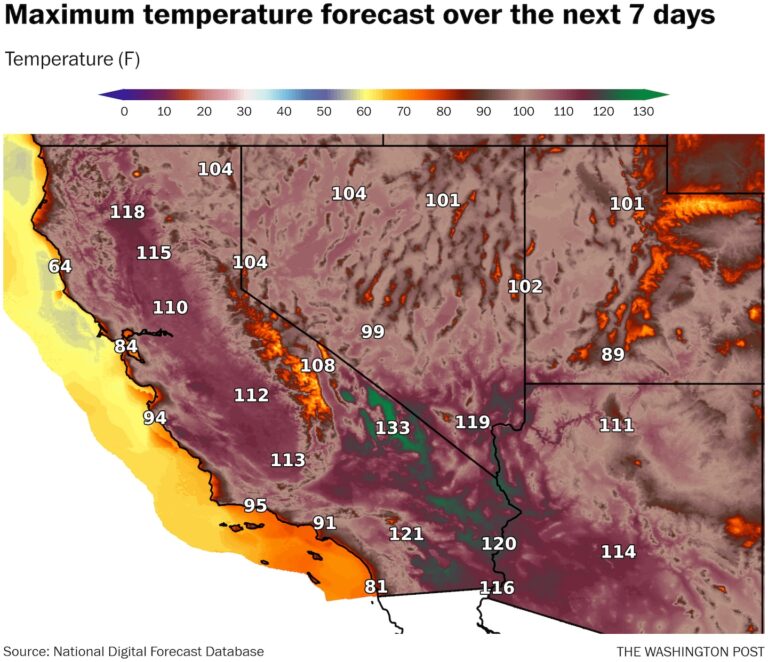Temperatures in the high 100s to high 120s will be a daily occurrence across much of the state, while low nighttime temperatures will offer minimal relief. A powerful and unusually persistent heat dome will kill clouds and also keep cooler fog at bay. The heat will also fuel a growing threat of wildfires; already, the Thompson Fire in Northern California has grown to more than 3,000 acres and destroyed structures.
Dangerous heat is projected as far into the future as reliable forecasts are available. Historical records approaching 120 degrees could be threatened as far north as Redding, while Death Valley could approach 130 degrees, which is the highest reliably measured temperature on the planet.
The weather service warned that “numerous heat-related deaths and repeated power outages” are possible.
The heat wave comes in the middle of the hottest year on record on the planet. The past 13 months, including June, have seen record-breaking heat. Human-caused climate change has increased the likelihood of this week’s heat wave in California by a factor of five, according to the science communications agency Climate Central.
The following maps help illustrate the severity of the coming heat.
Heat warnings cover 70% of the state
More than 70% of California is under a heat warning. Some of the heat warnings issued by the weather service extend for seven days, an unprecedented length of time, according to the San Francisco Chronicle.
Cities under excessive heat alert include Redding, Sacramento, Fresno, Bakersfield, Santa Barbara, Burbank and Palm Springs.
Heat advisories, for slightly less extreme conditions, are in effect for Los Angeles, Santa Maria, San Francisco and other coastal cities as well as parts of the Sierra Nevada. A few locations right on the coast are not affected by the warnings.
Temperatures could soar above 130 degrees
The numbers are alarming: Large portions of California will see temperatures above 110.3 degrees Fahrenheit next week. Some areas will exceed 119.5 degrees Fahrenheit. Only areas along the immediate coast and on the highest peaks will escape triple digits.
Death Valley, which holds the record for the highest temperature ever measured on the planet, is forecasting maximum temperatures of 126, 128, 130, 131, 131 and 133 over the next six days. Its world record maximum temperature of 134 was set in 1913, although questions remain about the reliability of that measurement. In 2020 and 2021, it reached 130 degrees, the highest temperature reliably observed in modern records. Last summer, it reached 129.
Heat dome reaches near-historic intensity
The heat dome responsible for the extreme temperatures is expected to reach near-record strength and remain parked over California and the southwestern United States for seven to 10 days.
“This is the warmest synoptic pattern we have observed,” wrote the weather service office in Las Vegas, where record highs could be reached.
The heat will not be limited to California, but will also affect much of the Southwest and at times extend into the Pacific Northwest as well.
Studies have shown that heat domes like this one are becoming larger and more intense due to human-caused climate change.
Weather services are predicting an avalanche of heat records and high minimum temperatures. Hundreds of records will likely be broken before the heat wave ends.
Single-day records will be the most common, but some monthly and even all-time records could be at risk. The number of records set will increase through Thursday and peak between Friday and early next week.
Some of the all-time records in jeopardy include 121 in Palm Springs on Saturday, 118 in Redding on Saturday and 118 in Las Vegas on Monday.
Extreme heat could persist for 7 days
The federal government’s heat risk index of 0 to 4 is expected to reach levels 3 and 4 — considered major and extreme — every day for at least the next week in the Central Valley and deserts.
At these levels, the risk of heat-related illness increases significantly, especially for vulnerable groups such as outdoor workers, the homeless and the elderly.
While major coastal cities will be mostly spared, areas just inland will experience several days of dangerous heat.
Jason Samenow contributed to this report.


